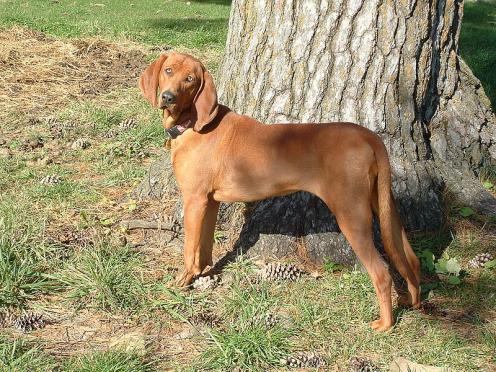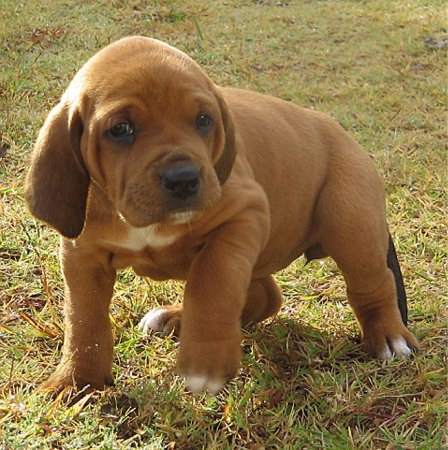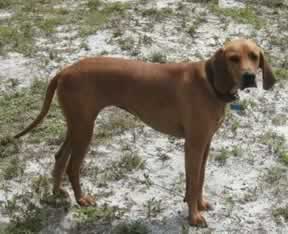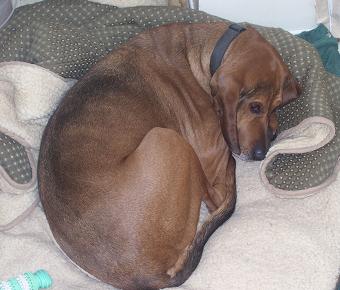| |
|
|
Redbone Coonhound Information

Redbone Coonhound Facts
| Size |
Medium |
| Male Max Weight |
45-65 lb |
| Female Max Weight |
45-65 lb |
| Life Span |
12-14 years |
| Energy Level |
 |
| Ease of Training |
 |
| Grooming |
 |
| Shedding |

|
| Exercise Requirements |

|
| Playfulness |

|
| Affection Level |

|
| Good With Dogs |

|
| Good With Pets |

|
| Good With Strangers |

|
| Watchdog Ability |

|
| Protection Ability |

|
| Cold Tolerance |

|
| Heat Tolerance |

|
Redbone Coonhound Temperament
|
Redbone Coonhounds, also called just “Redbones” for short, are typically
very mild-mannered, gentle dogs that don’t get effected much by their outside
surroundings. They enjoy being around people but are not as “annoying” or “in your face”
as other breed’s may be that constantly thrive for attention. They like attention, but they
don’t yearn for it if it is not given to them all of the time. They are smart dogs that become
bored with regular training. When they are on the hunt, they are extremely active and physical,
but indoors they are quiet and very well-behaved. Once their nose gets whiff of a scent that
they are hunting, they will ignore everything else in their surroundings. They get along very
well with other people, children, and other dogs. If smaller pets are in the household, they
may tend to chase them.
|
Redbone Coonhound Upkeep
|
Because this breed will follow a scent at high speeds, it is important to only
let this breed run free if it is in a fenced in area, or it may get carried away with whatever
it is hunting. A long, daily walk or job should be enough to satisfy the physical needs of this
breed. A hike will also suffice, however, if you take this breed on a hike, make sure you have
it on a leash so it doesn’t stray to follow its nose. They make wonderful inside dogs, as they
are very family-oriented. They do drool and have a loud bark when excited. Their coat only
requires minor brushing.
|
Redbone Coonhound Health
|
As for health, this breed is particularly very healthy. There are no major,
minor, or occasionally seen conditions that target this breed. It is suggested, however, to
test your Redbone’s hips periodically to ensure they are properly
functioning.
|
Redbone Coonhound History
|
The history of the Redbone Coonhound dates back to when Scottish immigrants
brought red foxhounds into American during the late 1700s. This is the reason that they are
derived from red foxhounds. George Birdsong, a hunter that inhabited Georgia, influenced this
dog breed’s development massively. He obtained a pack back in 18400 and as more coon hunters
took a fancy to the breed, they set out to create a faster,, better scented dog that was able
to find and catch raccoons better. They crossed the initial breed with imported Red Irish
Foxhounds. The outcome of this breed crossing was initially referred to as Saddlebacks because
they tended to have black saddles on their red fur, however, breeders emphasized their reddish
coat for several generations which allowed it to finally only have a solid, red-colored
coat. This was considered an unusual thing to fancy at the time. After the black saddle was
bred out of the breed’s DNA, they became known as the Redbone Coonhounds, which is what they
are referred to as today. Peter Redbone, a Tennessee breed enthusiast, was also part of the
reason the first part of their name is Redbone. In 2001, this breed was admitted into the AKC’s
Miscellaneous class. To this day, the breed remains a favorite amongst
hunters.
|
Redbone Coonhound Pictures
|
Puppies

Middle Aged

Older

|
Redbone Coonhound Videos
|
|
|







